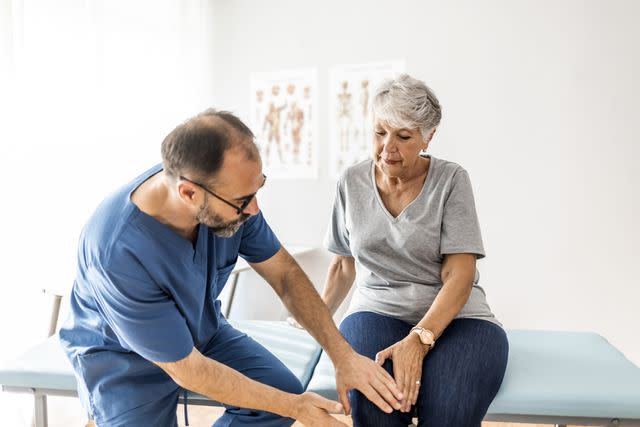Rheumatism: Characteristics of a Group of Diseases
Rheumatism is a group of conditions affecting joints, muscles, and connective tissue. While several different conditions are classified as rheumatism, all of them share similar symptoms of joint pain and inflammation.
This article will discuss the different types of rheumatism, how they are diagnosed, and general treatment options for these types of conditions.

ljubaphoto / Getty Images
Terms to Know: Rheumatism, Rheumatoid, and Rheumatic Diseases
"Rheumatism" is a general term used to refer to any disease characterized by inflammation and pain in the joints, muscles, or connective tissue. In medical terms, "rheumatism" is more often referred to as "rheumatic diseases."
The word "rheumatoid" describes a form of arthritis—rheumatoid arthritis—which is a rheumatic disease. Also, rheumatoid factor is an inflammatory protein in the blood associated with rheumatoid arthritis.
Learn More: Types of Arthritis and Rheumatic Diseases
Rheumatism vs. Arthritis
Rheumatism refers to all conditions that cause pain and inflammation of joints, muscles, and connective tissue. Arthritis is one type of rheumatism that can affect any joint. There are several different forms of arthritis, including osteoarthritis from wear and tear and degenerative changes, and rheumatoid arthritis, an autoimmune condition.
Classifying Rheumatism: Types of Diseases
"Rheumatism" is an umbrella term that encompasses many different conditions. These disorders affect joints, muscles, or connective tissue and can be autoimmune or non-autoimmune.
Non-Autoimmune
Non-autoimmune types of rheumatic diseases are commonly occurring conditions. The most common non-autoimmune disorder is osteoarthritis (OA), which causes joint pain, stiffness, and inflammation from cartilage breakdown. Osteoarthritis can affect any joint, although the hands and fingers, wrists, spine, hips, and knees are most common.
Other non-autoimmune rheumatic diseases include:
Autoimmune
Autoimmune rheumatic diseases result when the body produces antibodies that attack its own joints, muscles, and connective tissue. This results in chronic (ongoing) inflammation throughout the body.
Autoimmune rheumatic diseases include:
Spondyloarthropathies, including ankylosing spondylitis and psoriatic arthritis
Takeaway
Rheumatoid arthritis is three times more likely to occur in women than in men. Symptoms typically begin between the ages of 30 and 60.
Read Next: Rheumatoid Arthritis Age of Onset
General Rheumatism Symptoms and Sensations
Rheumatism symptoms involve pain and inflammation of the body’s musculoskeletal system. The symptoms can be experienced throughout the entire body, or they may be limited to a certain area. These symptoms include:
Joint pain
Joint swelling
Joint stiffness
Chronic pain or tenderness
Warmth and redness around joints
Limited joint movement
Fatigue
Steps to Get a Rheumatism Diagnosis
Generally, no single test alone can diagnose any of the rheumatic diseases. Instead, your healthcare provider will make a diagnosis of a rheumatic disease based on your symptoms, a physical exam, and diagnostic testing. Many symptoms of rheumatic disease overlap with each other, so it may be difficult to get a correct diagnosis at first.
Blood tests can detect elevated levels of inflammatory markers or antibodies associated with autoimmune conditions. Imaging scans, such as X-rays, magnetic resonance imaging (MRI) scans, or computed tomography (CT) scans examine the extent of joint damage and inflammation.
Risk Factors
Rheumatic diseases result from a variety of different risk factors. These include:
Genetics
Environmental triggers
Lifestyle choices that increase inflammation throughout the body
Infections
Metabolic disorders
Physical trauma or overuse
Treatment and Management Options
Because there is no cure for rheumatic diseases, a variety of different treatment options are used to help manage symptoms.
For autoimmune rheumatic diseases, different types of medication can help decrease inflammation throughout the body. These include glucocorticoids to reduce inflammation, and disease modifying anti-rheumatic drugs (DMARDs) and biologics to reduce autoimmune disease activity.
For all rheumatic diseases, medications such as the following may be useful to help alleviate pain:
Besides medications, other treatment options can be beneficial to improve your quality of life and everyday functioning. These include:
Physical and/or occupational therapy to improve joint mobility and functional strength
Stretches and regular exercise
Heat or cold treatment to decrease stiffness and reduce pain and swelling
Splints or braces to help stabilize and protect your joints
Assistive devices like walkers, canes, or crutches to help with walking
In cases of severe joint inflammation and damage, joint replacement surgery may ultimately be needed for improved function and lasting pain relief. Joint replacement surgery is most often performed on:
Knees
Hips
Shoulders
Rheumatism Flares: Adjusting to Chronic Management
For chronic management of rheumatism and rheumatism flares, following healthy lifestyle habits can help lower levels of inflammation throughout the body to lessen the severity of symptoms. Self-management strategies include:
Managing stress levels and staying connected to others
Staying physically active while avoiding high impact and repetitive movements that can stress joints
Maintaining an anti-inflammatory diet
Getting adequate, interrupted sleep each night
Supplementing with vitamin D to decrease the risk of osteoporosis (reduced bone density and mass, leading to brittle bones)
Summary
Rheumatism, also called rheumatic diseases, is an encompassing definition used to refer to various conditions that cause pain and inflammation in joints, muscles, and connective tissue. Rheumatism can be non-autoimmune, like osteoarthritis or gout, or autoimmune, like rheumatoid arthritis, psoriatic arthritis, ankylosing spondylitis, and lupus. Symptoms of all rheumatic diseases include joint pain, stiffness, swelling, and limited range of motion.
A single test alone cannot diagnose rheumatism. A healthcare provider will look at your symptoms, take a physical examination, imaging, and blood work will help determine a diagnosis. While there is no cure for rheumatic diseases, medications, physical therapy, bracing, and heat and cold therapy can help manage symptoms. Following a healthy lifestyle to decrease inflammation throughout the body can help lessen severity of symptoms and decrease the likelihood of flare-ups.
Read the original article on Verywell Health.

